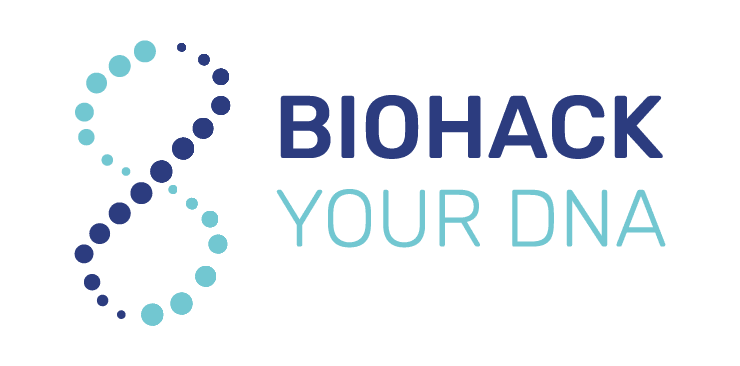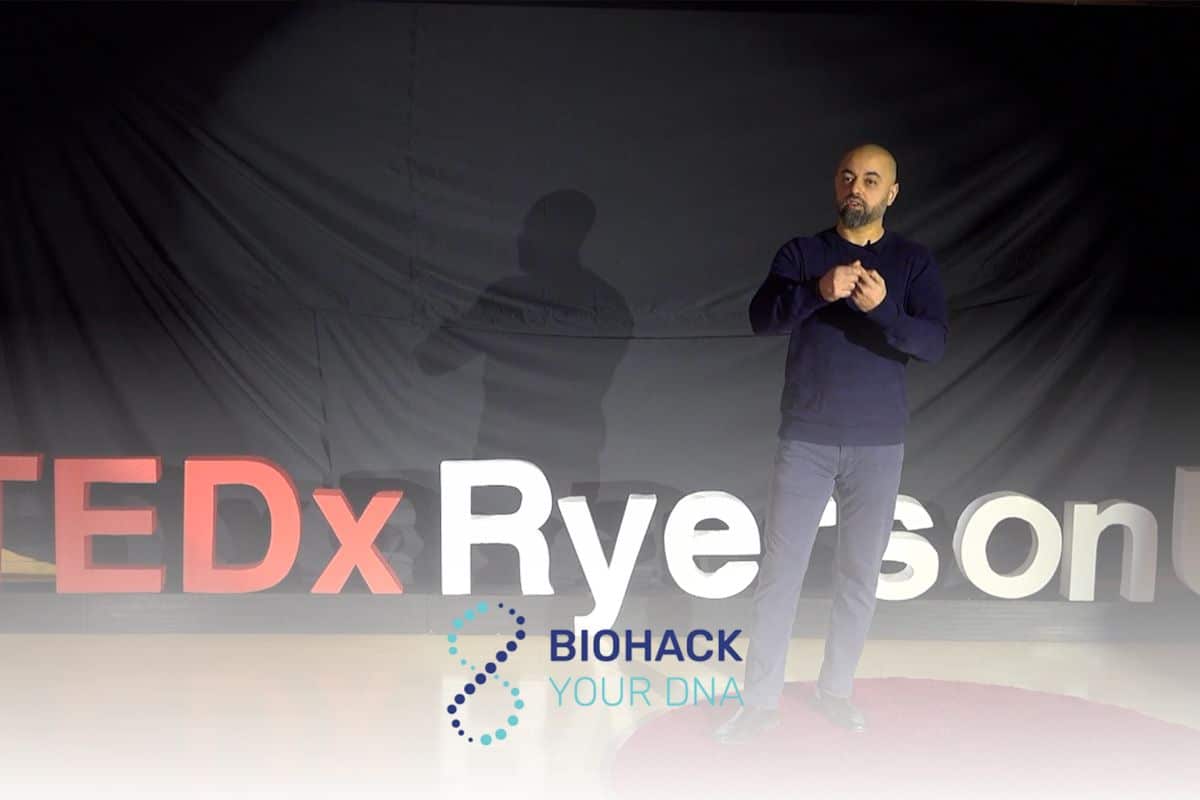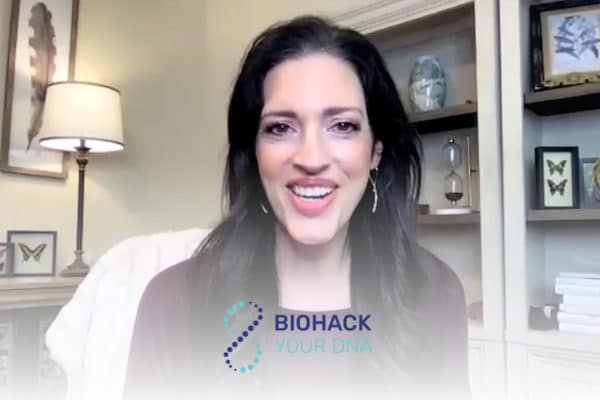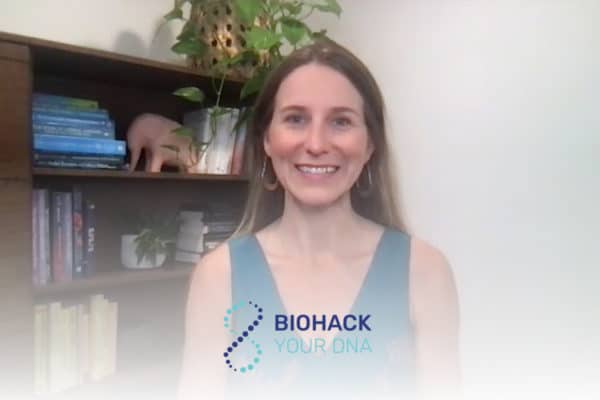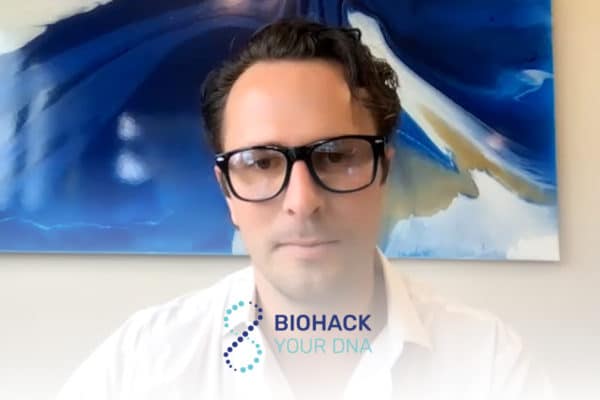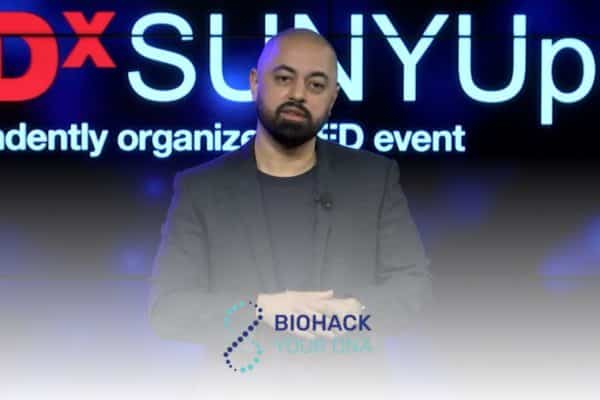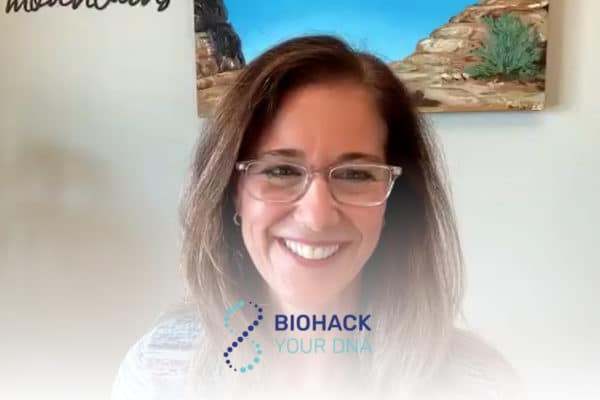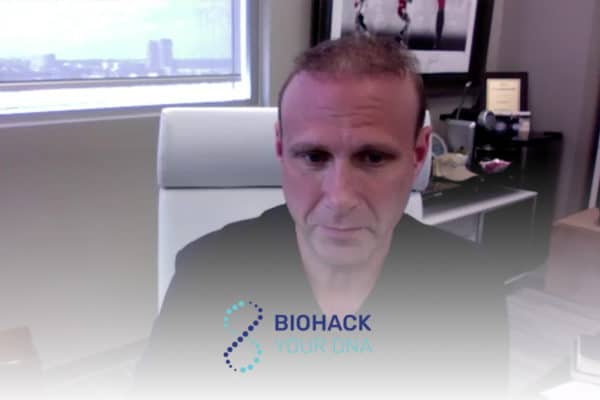So now, we ask the question, if so many billions of dollars have been spent on genetic research and decoding the human genome, why are we still sick? We have a $4 trillion healthcare budget, of which 90% is spent on chronic disease, meaning things that you’re not born with. Things like diabetes, cardiovascular disease, breast cancer; these all happen later in life when you’re 50 years old, you get your first chronic condition. And when you’re 60, you have two. And the North American dream is that you spend the last 15 years of your life in treatment. This is the average, and this is typically what happens for a North American. So, why is this happening? Well, we do a really good job of what’s called acute care, meaning that you break your arm, you have a terminal condition, you run to the hospital, they will fix you. We do an excellent job here. The challenge is, we use that same toolkit on chronic conditions, where masking the symptom or resolving the pain point isn’t enough. We need to ask, why did it happen in the first place? It didn’t start like the broken arm the time that it happened. It started 5, 7, 10, 15 years sometimes ago, prior to the actual symptomology. So, what is that thing that happened for that many years? Well, to put this into context, I’m gonna tell you a story, a story about a fish, a fish named Sushi. So, suppose I came to you and I gave you a bowl, and inside that bowl was a goldfish. And that was a gift to you. And we named that fish Sushi.
But you noticed that, in that bowl, it was highly toxic and polluted water. I know that all of you right now are already thinking instinctively, “Remove Sushi and replace her into another bowl or change the water.” You know what to do. What would happen if you left her in there? After some time, she would get eczema, some skin conditions, maybe psoriasis. She might start getting migraines, some mood issues, banging into the glass, just not feeling well. Eventually, maybe something bigger like cancer. And you know this, and this is why you wanted to remove her from the bowl. But what do we do with our chronic disease management? Well, we give Sushi a cream for eczema, we give her a pill for the migraine, we send her to some therapy about her mood and behavior issues, and if the cancer comes, we deal with it at that time. Meanwhile, you all knew what to do. So, why do I know this? I was Sushi. I literally had all these problems. I had eczema, I had psoriasis, I had debilitating migraines where my business partner used to have to drive me home, and we would literally have to stop the car ’cause I would vomit from the pain. In that journey, I was going to a doctor for this, taking a pill for this, a cream for this, getting a scan at the hospital for something else, treating all of these conditions as independent siloed events, when they were all rooted in a failure in my genetic code. That’s when I discovered that I could actually dive into my genome and understand why these things were happening, not masking their symptoms. I stand here today before you, healthy.
I have not since had any of these problems, because I now understand what to do about them. The last thing that hit me was the depression. These were all the pain points I felt, but there were some days where I just didn’t even wanna go to work because I couldn’t get outta bed, and I started to understand that as well. So, the healing was done, the mood and behavior was corrected, and all of a sudden, I stand in front of you, healthy. So, we know that this is true, but still, there’s a sort of sense of genetics being underwhelming. You don’t go to the doctor and are told about your genome. The doctor doesn’t understand how to apply it. And this is because, just like in that sick care model where we only ever mask the disease, genetics has been built to mirror that; that we only speak about problems. When you get a DNA test report, it will tell you you have an 80% chance of Alzheimer’s. Well, what does that give you other than anxiety for 30 years, waiting to see? What we should be asking, if we wanna be healthy, we should not only study the sick; the 80% that got Alzheimer’s; to understand that this is where you get there, this genetic profile. What about the 20% that didn’t get it? If I’m telling you that this genetic profile equals a 80% chance of Alzheimer’s, I’m also telling you 20% didn’t get it. What were they doing differently? Well, the difference is a weak gene profile.
You’re not doing well with some cellular process. Means that you were still born healthy, but if you are exposed to the wrong environment, nutrition, and lifestyle mismatched to your genetic capacity, you may get sick. Meanwhile, if you have the correct environment, nutrition and lifestyle, like the 20%, you won’t get sick. So, we need to study them, and understand how to stay healthy. That God-given gift of the health you’re born with, you should be able to maintain until you die. So, to put this into further context, I’ll give you an example, a clinical example. Everyone’s familiar with the BRCA gene, it’s a very well spoken of gene because it causes a big problem; breast cancer. Well, when I say caused, that’s what we’re told. What does BRCA actually do? BRCA is a tumor-suppressing gene. So, once you actually have cancer, it’s meant to go fix and repair and get rid of that tumor. It also repairs DNA, and essentially goes through your body as a repair tool. If you had the bad version of BRCA, you’re not doing that job quite well. Meanwhile, it’s not causing cancer. So then, what does cause the cancer? Well, we start to look at, well when do women get cancer? Breast cancer, we’re talking about particularly. Usually in and around the menopause age. What happens at the menopause age? And I’m not saying all, but for the most part; around that time, menopause. During that time, you no longer have a menstrual cycle.
So, let’s start to dive into that biochemistry. What’s the shift if you don’t have a menstrual cycle? Well, when you look at the genetics of hormones, there’s some women who are more estrogen-dominant. It’s not taken for granted that men are testosterone, women are estrogen; there’s a lot of combinations in that cascade, and you can fall in many different places. Some women just fall in a much heavier pool of estrogen. That’s step one of three. Step two is, what is the metabolite? You don’t clear estrogens in your monthly cycle, you first convert it into either 2, 4, or 16 hydroxyestrone; one of the three. 2 is great, that’s what you want. 4 and 16, highly toxic. And if that’s what you make, it’s not good news. Step three is, you need to clear it. Just like when you drink alcohol, you know that you send it to your liver to metabolize and get rid of it, your body does this with all toxins, including toxins that you create from your hormones. Some people, genetically, don’t do that well. And by studying this human genome, you can understand that before asking questions to the patient. So, if you are that woman that is estrogen-dominant, estrogen-toxic, with the genetic inability to clear those toxins, well then you’re dealing with a problem that you don’t even know is there. Then also, when you get to that menopause age, you no longer have the menstrual cycle to clear that toxic metabolite. But even then, it doesn’t mean you’re getting sick. Again; environment, nutrition, lifestyle. Why is it only some women have the problem? Well, some women, like 85% of North American women, will take a birth control pill for an elongated period; more estrogen fueling that estrogen toxicity fire.
Some women, as they age and get into the menopause age, will take a hormone replacement therapy to make their bones healthy and their skin beautiful and stay young, adding more estrogen to that estrogen toxicity fire. Some women don’t realize that that Teflon coated frying pan, or that pesticide they’re using in the grass, or a chemical in some paint mimics hormones as it enters your body, and endocrine disruptors they’re called; adding more estrogen to that estrogen fire. So then, all of a sudden, you know you have this profile that puts you at risk. You have a 80% chance of breast cancer. But you don’t get there until you make the wrong choices. Or you could understand your genome and make the right choices. So, why then, again, does this happen at menopause? Well, when you have this toxic threat and you’re no longer clearing it with the monthly cycle, your body wants to keep you safe. So, it stores it in fatty tissue. Let’s get the toxins away from the organs. Where do women have fat? In the hips and in the breasts. And what’s in the breasts that was never designed to deal with that level of toxic insult? All these glands designed to deliver milk that are now inflamed, that eventually lead to cancer. That’s when BRCA’s supposed to get to work. BRCA’s the repair tool, it’s not the cause of cancer. And we study this clinically to say, “BRCA is bad, go get a mastectomy.” Meanwhile, we don’t ask why does the disease happen? And you can do this for every disease. It’s important to also understand, as you unpack disease and potential to get sick, mood and behavior.
How do you even perceive? ‘Cause you can’t understand how to deal with it until you know how you personally think about it. And I go back to my depression as an example of how the brain works. When you understand genetics, you don’t ever need to meet somebody to understand how they think, how they behave. It’s important to understand that there’s chemicals in your brain that drive exactly how you act with people, how you perceive things; including myself, where, because my dopamine levels; dopamine is a chemical that allows you to feel pleasure and allows you to feel reward; were low, I didn’t feel the same way other people felt. But guess what? There’s two more steps to that process. You have to bind dopamine, that chemical that makes you feel happy and makes you feel pleasure, but there’s an enzyme, sorry, a gene called COMT; MAO, sorry, gene called MAO that breaks it down before COMT, the enzyme, is then deployed to clear it out. I had the low dopamine and the ultra fast MAO and the ultra fast COMT. So, I feel it way down here and it lasts that long. I have three options. Depression, which I did have, because I just don’t get to feel. Addiction, because I go down that pleasure path and I start to enjoy something and get hooked on it. Or achievement, because I go down the reward path, ’cause dopamine does both.
So, as an entrepreneur, my father actually passed away when I was 17, and I became responsible for the family. And so, I went down that entrepreneurial route of having to work and build and feed the family. And I kept going down that path. And when I got comfortable, I stopped doing that, and then I got depressed ’cause I stopped getting the reward. So now, understanding that about myself, I can build the right context to avoid what would be considered a disease. I haven’t been depressed since the day I found this out. I wanna bring this back to one big problem. There’s a huge problem which will affect 50% of north Americans. 30% of Americans died of this. Of the American deaths, 30% were this. 18 million people globally, 66% of women that get this will die on the first instance with no previous warning signs or symptoms, and it’s cardiovascular disease. The thing that kills the most of us but is the most easily preventable, if you were to understand your human genome. So, a dear friend of mine, we actually worked with him; since I healed myself, I also healed by friend; and we understood that his cholesterolemia, at the age of 38, he was taking a pill, what’s called a statin, to reduce his cholesterol numbers ’cause they kept going up. And we started to unpack, well what’s going on there genetically? Well, first we looked at, you can determine what quality hardware you have. And this is very important, ’cause most heart disease doesn’t happen in the heart; it usually happens in the arteries around the heart. And you can actually look into your genome and see, do I have the stainless steel Teflon coated arteries like grandma that smokes till she’s 95 years old and doesn’t get sick, and you wonder why? Or do I have the more sensitive, prone to inflammation, bad quality hardware? That’s what he had.
But even then, he wasn’t born sick. We then looked at his habits. What was he doing? And the thing that we pinpointed that was actually leading to his problem was that he was golfing four days a week, which was completely counterintuitive and didn’t make sense. But what was happening when he was golfing four days a week? He was breathing in all these toxic pesticides that made that golf course look so beautiful. So, what was going on there genetically for him, there’s a very specific gene that helps you do this process of binding on this sort of traffic cop in your blood that binds onto these toxins, gets rid of them. And he didn’t even have the gene. Forget about what version or what variant that you often hear of, or a snip, or a version; he didn’t even have the gene. It was a page torn out of his human instruction manual. So, he didn’t do that process. So, unlike his friends that were golfing with him, when he went and was breathing those chemicals in, it was wreaking havoc on his highly sensitive arterial walls; that inner wall called the endothelial which he had the worst diversion of. So, now he has inflammation here, which you don’t feel and there’s no symptoms. The body’s response to that inflammation caused by these pesticides wreaking this havoc is to actually deploy cholesterol as a hormone to reduce the inflammation.
What happens when the cholesterol meets toxicity? It hardens and gets deposited. So, that is the beginnings of that disease, for which, again, a symptom was being masked instead of asking the question of “Why?” What else was he doing? Well, the four days that he wasn’t playing golf, he was playing tennis because his cholesterol numbers kept going up, and he thought he had to exercise. So, what happens when you play tennis? You get into a high level of what’s called cardiovascular activity, which causes oxidative stress. What is that? All the cells in your body take in nutrition and oxygen to create energy. This is their job. In that process of using oxygen as fuel, you also create oxidants. The same thing that gives you life literally slowly ages you and kills you. It’s a toxin. You’re supposed to be able to clear that and get rid of it. There’s a gene called SOD2, which determines how well that the mitochondria, that powerhouse of the cell, that you do this; that process of getting rid of the smoke. He didn’t do that. He had the worst version of that gene. So now, all of a sudden, you have a guy that’s playing tennis three days a week in high cardiovascular output, creating all these oxidants that he couldn’t clear; another layer of what was causing inflammation to that endothelial lining, that inner lining.
So, he had a double whammy; two layers of exposure causing this problem, leading to that cholesterolemia, which then made him sick. So, with what I’ve laid out here, you can see that understanding your genome allows you to highly personalize why you and me and everybody else get sick. It’s not a question of waiting to see, or my mother had this or grandma had this. What do I have? Your instruction manual is already trying to tell you that. Whether it’s anxiety, depression, Lyme disease, whether it’s autism, all these things, you may have something. To what degree does it express? How sick do you actually get? Your ability to cope. It’s all in that instruction manual. What are you built of? What are you made of? So now, we skip ahead, going back to Harvard. What did Harvard say? They said five things. If you wanna add 14 years to your life, beyond the typical North American expectancy, you don’t smoke, you don’t drink more than one drink a day, you maintain a healthy weight, you eat well, and you exercise three hours a week. Any child knows that. This is how sick we are, and how much opportunity there is to get healthier. If those five things can extend your lifetime by 14 years, taking you to almost 100, I would argue, if you decode the human genome and just look at a few of the snippets we talked about today and apply that to any disease, we should get to 150. And it’s not just about age. In that age, you want vitality, you want health. You’re born healthy, you should continue to be healthy, and drop dead healthy of a coconut falling on your head when you’re on vacation. You should not die from being sick. This is how we are born, this is how we should stay. So with that, I would say, not only can you add years to your life, but in those years, you can also add life to your years. I thank you for listening.
